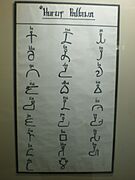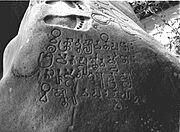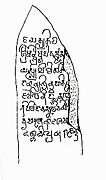Pallava script facts for kids
Quick facts for kids Pallava script |
|
|---|---|

'Pallava' in Pallava script
|
|
| Type | Abugida |
| Spoken languages | Tamil, Old Khmer, Old Malay, Burmese, Thai, Sri Lankan Sinhala, Lao, Mon, Balinese, etc. |
| Time period | 4th century CE to 8th century CE |
| Parent systems | |
| Child systems | Tamil, Grantha, Mon-Burmese, Khmer, Cham, Kawi |
| Sister systems | Vatteluttu |
| Note: This page may contain IPA phonetic symbols in Unicode. | |
The Pallava script is an ancient writing system. It is named after the Pallava dynasty from South India. This script was used from about the 4th century CE to the 8th century CE. In India, the Pallava script developed from another script called Tamil-Brahmi.
The Grantha script also came from the Pallava script. The Pallava script was very important because it traveled to Southeast Asia. There, it became the base for many other scripts. These include Balinese, Baybayin, Javanese, Khmer, Lao, and Thai.
Contents
History of the Pallava Script
The Pallava script began in Southern India. It was developed by the Pallavas, a powerful ruling family. They based it on the older Tamil-Brahmi script. The new Pallava script had rounder and fuller letters. These letters looked very nice and were good for writing.
This script was used for important writings. These included both official and religious messages. It was also similar to scripts used by other kingdoms like Chalukya and Kadamba.
How the Script Spread
The Pallava script spread across Asia. Priests, monks, scholars, and traders carried it with them. They traveled from India to different parts of Southeast Asia. This helped the script become popular in many new places.
Over time, the Pallava script changed. It adapted to local languages and writing styles. For example, the Kadamba-Pallava script led to early forms of the Telugu-Kannada script. Letters became even more rounded. This happened partly because people started writing on leaves and paper.
Modern Use and Future
Today, the Pallava script is not used for everyday writing. However, people are working to preserve it. There have been ideas to add the Pallava script to Unicode. Unicode is a system that lets computers show text from all languages. This would help people study and use the script digitally.
Understanding Pallava Script Letters
The Pallava script is an Abugida. This means each main letter is a consonant. It also has a basic vowel sound attached to it. If you want a different vowel, you add a special mark.
Consonant Sounds
In Pallava script, each consonant usually has an "a" sound. For example, the letter for "k" sounds like "ka." If two consonants are next to each other without a vowel, the second one is written smaller. It is placed below the first consonant.
| ka | kha | ga | gha | nga |
|---|---|---|---|---|
| ca | cha | ja | jha* | nya |
| ṭa | ṭha* | ḍa | ḍha* | ṇa |
| ta | tha | da | dha | na |
| pa | pha | ba | bha | ma |
| ya | ra | la | va | |
| śa | ṣa | sa | ha | |
Vowel Sounds
Besides the "a" sound, there are also separate letters for vowels. These are used when a vowel starts a word. Or when it is a standalone sound.
| a | ā | i | ī | u | e | o | ai* | au* |
|---|---|---|---|---|---|---|---|---|
Examples of Pallava Script
You can see the Pallava script on old stones and temples. These examples show how the script looked. They also show how it was used in different places.
-
Pallava script at the 8th century Kailasanatha temple in Kanchipuram, Tamil Nadu.
-
The Ciaruteun inscription, a 5th-century Pallava stone inscription discovered in Indonesia
-
One of the oldest inscriptions discovered in Indonesia, the Yūpa inscriptions of King Mulavarman, king of Kutai Martadipura written in the 4th century AD





